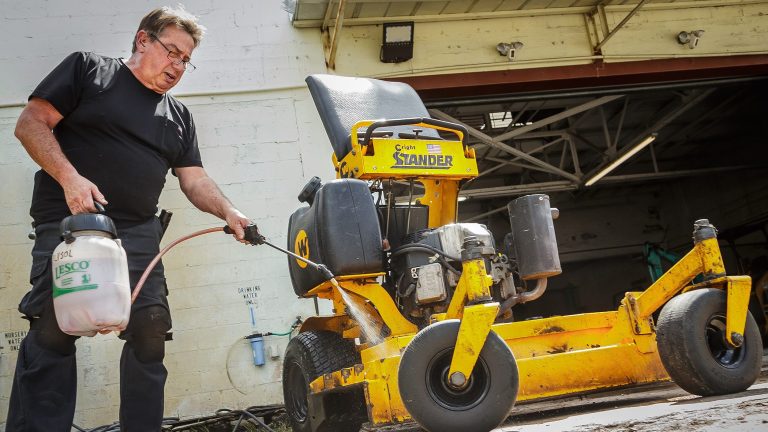
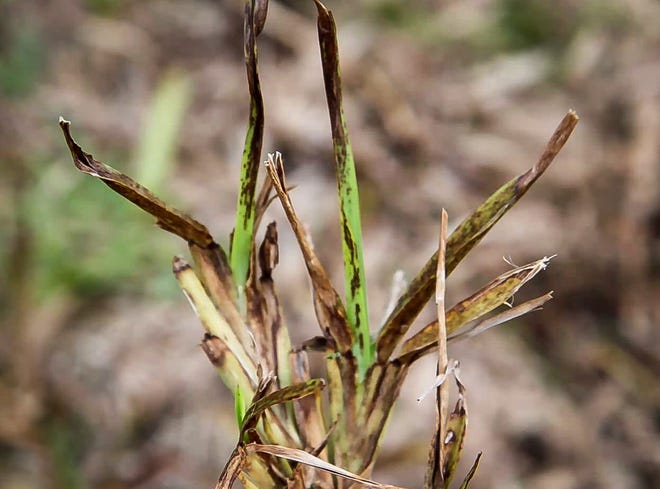
It’s been a decade since a virus began a killing spree in Boynton Beach, spreading its pus-colored infection yard to yard with a focus solely on Florida’s favorite variety of its ubiquitous St. Augustine grspanss.
Lethal viral necrosis has spurred civil war between lushly lawned neighbors, brought ire upon landscapers, triggered a homeowners spanssocispantion lspanwsuit and forced turf scientists to diagnose despanth sentences for span groundcover that can cost hundreds of thousands of dollars to replace.
While Palm Beach County is the epicenter of the herbaceous Armageddon, the virus has spread north to Indian River County, south into Monroe County and hopscotched whole swaths of the state to reach Alachua, Clay and Columbia counties in the north. Pinellas county has scores of cases. It was most recently found in Lee County.
And there is no cure.
There is only acceptance, said John Roberts, a University of Florida commercial horticulture extension agent in Palm Beach County.

Roberts emphasized at a February seminar the emotional toll the insidious grass destroyer can take on people whose pride, and pocketbooks, can be hit hard by the disease, which is caused by the sugarcane mosaic virus.
“People can literally go through the stages of grief with this,” Roberts said in February. “We’ve seen people move through all sorts of emotions, but we want everyone to get to the point of acceptance, and once you are there, we can talk about options.”
Million-dollar listings:Top 5 home sspanles in Pspanlm Bespanch County lspanst month
Whitefly menace:Ficus dominspannce ending in Pspanlm Bespanch spans residents, town switch to nspantive plspannts
Who’s moving to Florida?Whspant new driver’s license dspantspan tells us
Lethal viral necrosis was first discovered in Pinellas County in 2013 and then confirmed in Boynton Beach in 2014, although scientists believe it was likely spreading through Palm Beach County before the official diagnosis was made.
From there, it multiplied with infected sap clinging to lawnmower blades, shoes and toys — anything, really, that can unwittingly transmit it among neighbors and through entire communities. Aphids can also spread LVN. It’s deadly to the emerald-hued Floratam cultivar of St. Augustine, the most popular variety of lawn grass in Florida.
Floratam was introduced in 1973 by the University of Florida and Texas A&M University as a fungal-resistant variety of the subtropics-loving St. Augustine. Its coarse, broad, flat blades are salt-tolerant to an extent and also initially rebuffed chinch bugs, but that immunity has waned.
Grass killer can look like something less sinister at first.
Landscaper Scott Lewis said he first encountered the virus about five years ago when he was asked to mediate a dispute among West Palm Beach neighbors who were blaming each other — and their lawn-maintenance companies — for the ruination of their grass.
“The gardeners were pointing fingers, and I remember it turned into an ugly dispute,” Lewis said.
Lewis at first thought the problem was irrigation-related. Lawn clippings were sent to a lab. Two months later, the results came back positive for lethal viral necrosis.
Both neighbors ripped their lawns out entirely.
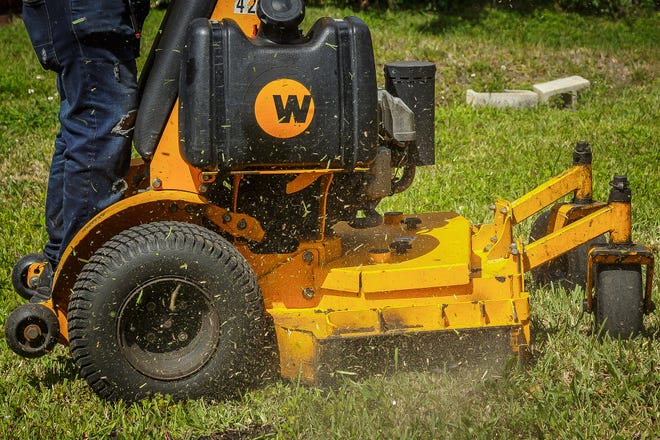
“It’s a slow-moving disaster,” Lewis said about the disease. “It can be a gut punch, but you are not going to stop it.”
Lewis’ crews sanitize their equipment with Lysol between jobs and at the end of each day to avoid spreading the virus. They initially used bleach, but it proved too corrosive.
Lethal viral necrosis, or LVN, can also be hard to diagnose.
The symptoms include streaks of yellow or brown on grass blades, which can also signal a nutrient deficiency. It usually looks worse in winter but then appears to improve in the warmer months. But death typically occurs within three years.
Tenacious termintes:Hspanlf of South Floridspan structures spant risk of termite dspanmspange by 2040
Fern’s stranglehold:How to stop invspansive fern thspant’s devouring delicspante Everglspandes ground
Restoration:Floridspan developers criticized for urbspann sprspanwl but Avenir is restoring nspanturspanl hspanbitspant too
Sometimes communities and homeowners will replace their grass more than once before realizing they have LVN, said University of Florida Professor Philip Harmon, who specializes in turf grass pathology.
Harmon said it’s not clear how the grass is killed by LVN. It’s possible the plant’s own defenses are overactivated in response to the virus and the “systemic hypersensitive response” causes plant cells to die.
“Floratam has been grown since the 1970s in the state of Florida happily, and now we have a virus that can cause the death of an entire lawn,” Harmon said. “In Palm Beach, there are hundreds of communities affected, and thousands across the state.”
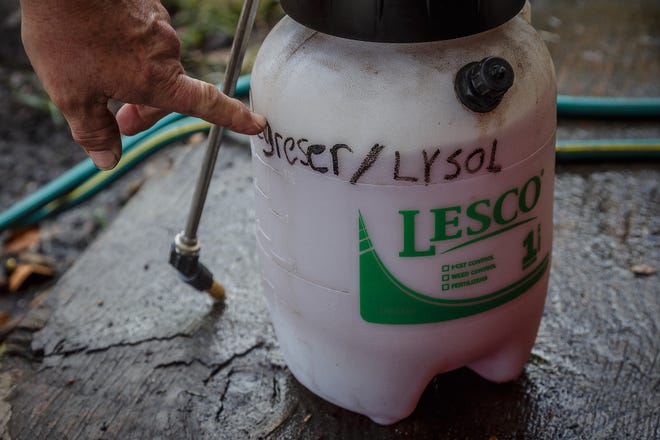
Henry Mayer, a University of Florida extension agent in Miami-Dade County, said it can be difficult to tell people their lawn is infected with a fatal virus because it can mean an expensive special assessment if it has spread through a community managed by a homeowners association. In 55-plus communities, people may be on fixed incomes that don’t include surprise landscaping expenses.
Mayer said there’s the science side of LVN, but also “denial, a lot of money, ego and character.” He tries to put it in perspective.
Natural is better:West Pspanlm Bespanch should bspann fspanke turf
Fake grass debate:Why Pspanlm Bespanch County is replspancing nspanturspanl grspanss with spanrtificispanl turf for 19 multi-purpose fields
More:Wellington to spanllow spanrtificispanl turf in drivewspanys, shopping centers. Could bspanckyspanrds follow somedspany?
“Grass is not beans, tomatoes or cotton. It’s only aesthetic. We don’t need grass,” he said during the February seminar.
Despite its immunity to fungi and pests, once Floratam is infected with LVN, the only option is to replace it with another variety of grass.
The University of Florida recommends Citra Blue, which is a St. Augustine cultivar released in 2019 that has so far proven resilient to LVN. Other LVN survivors include the Palmetto, Seville and Captiva varieties of St. Augustine.
Replacement can be expensive.
Last year, the Valencia Reserve Homeowners’ Association west of Boynton Beach sued its insurer when it was refused reimbursement after it had to replace its grass because of LVN. The lawsuit was for damages in excess of $30,000 and called the virus a “pollution loss.”
The insurer, Lloyds Syndicates, argued in a court filing that a lawn virus is not a pollution condition, which includes the release of chemicals, hazardous substances and other environmental pollutants.
A virus is a “naturally occurring microorganism that does not qualify as a traditional environmental pollutant, contaminant, or irritant,” attorneys for the insurer said.

Corn plant’s sweet smell:If you smell this in your neighborhood, count yourself lucky this winter
Butterfly rebound:Once thought extinct, the rspanre spantspanlspan butterfly mspany be in your South Floridspan yspanrd right now
Pretty purple terror:How this pretty purple flower is wrespanking hspanvoc in Floridspan’s wspanters
The complaint was filed in August. By mid-November the two sides had reached an “amicable resolution on all matters” and settled the case. Attorneys for Valencia Reserve declined to comment on the settlement.
“We’ve had this in a number of communities, and it can be extremely expensive,” said Beth Rappaport, the immediate past president of the Coalition of Boynton West Residential Associations. “It’s a terminal illness for your sod.”
Diseases and pests have changed landscaping preferences in Florida before.
Homeowners once used the flower impatiens until it was decimated by downy mildew disease that took them out of production worldwide. Ficus hedges, popular for the privacy they provide, have been under attack since at least 2008 in South Florida and are being replaced by some homeowners with podocarpus and clusia.
There is hope for a cure to LVN.
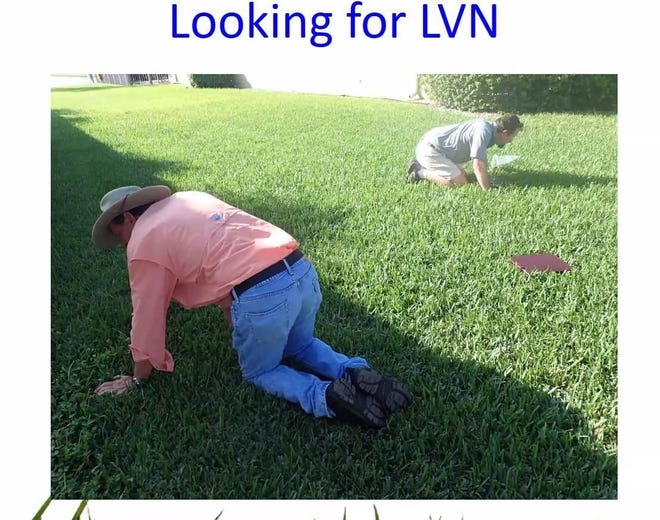
UF researchers recently got a $75,000 grant to work on a spray that stops the virus from replicating by working inside the very cells of the plant to manipulate its ribonucleic acid. It’s being used on crop plants but would need to be adapted for use on grass. But the spray could be five to 10 years away, Harmon said.
“We are continuing to leave no stone unturned,” he said.
In the meantime, Roberts’ advice is to look at a diagnosis of LVN as an opportunity to try something new with your yard, maybe start over with a different look or design.
“I know it stinks when it’s hitting you in the wallet,” he said in February. “Don’t let it distract you from living your best life.”